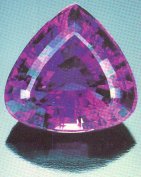|
Probably
the most recognized variety of Quartz, Amethyst has
long been loved for its wide range of purple hues.
Lore says that the maiden Amethyst was turned into
crystal to protect her from Bacchus' tiger. The Greek
god of wine was so contrite that he wept tears of
wine over her frozen form, giving Amethyst its lovely
color.
Amethyst
derives its name from the Greek word "amethystos"
meaning "not to intoxicate." The ancients believed
that it had the power to prevent drunkenness and consequently,
they did their drinking from carved amethyst mugs.
In fact, the clergy of the Roman Catholic Church still
wear amethyst rings to protect themselves from intoxication
when drinking the Communion wine. In addition, few
people today realize that the ancients not only believed
amethyst had a sobering effect on intoxicants, but
that it would quiet the overpowering excitement of
love passions. It is also very possible that amethyst
derived its supposed virtue of preventing drunkenness
from the fact that if a liquid is poured into a vessel
made of amethyst, the liquid would appear like wine
and would therefore be consumed with no intoxicating
effects.
Roman
women believed the purple gem would keep their husbands
faithful. Strangely enough, many men believed just
the opposite: that an amethyst would attract beautiful
women to them. Kings and queens considered amethyst
a perfect compliment to their royal robes, and eventually
the gem came to symbolize royalty. Amethyst can be
found in the Crown Jewels of many countries. Amethyst
adds rich color to any piece of jewelry. It is glorious
when offset with gold and can be further enhanced
by the company of pearls or diamonds. Its setting
and the company it keeps can make it anything from
simple to sophisticated to extravagant.
Suggested
as a gift for a sixth wedding anniversary, Amethyst
is the February birthstone.
|
